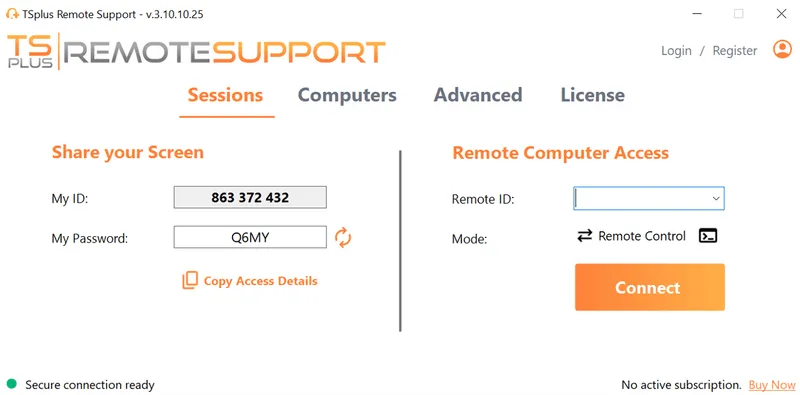)
)
Why Would You Need To Connect to Another Screen?
Productivity: More Space, Less Friction
For professionals, especially those working remotely or on the move, additional screens mean a clearer mental map of tasks. Designers span their tools across monitors; developers code on one and test on another; writers research on one screen while drafting on another. Software like DisplayFusion or built-in OS utilities make it easier to manage this digital workspace, even automatically remembering layouts.
Entertainment & Casting
Watching a video on a small screen while holding it in your hand is functional. But casting it to a big screen transforms the experience. Whether through AirPlay, Miracast or apps like Plex, people increasingly use software to move media between screens, not just duplicating it, but enhancing how it can be “consumed”.
Collaboration & Remote Support
From virtual classrooms to IT support, screen sharing has become a foundational workflow. Tools like TeamViewer or Zoom’s screen share do not just connect you to another screen, they allow you to work on it, with it, or for someone else, all in real-time.
Creative Work & Innovation
Music producers, video editors and digital artists use multi-display setups to separate control panels from work areas. With software like Duet Display, even an iPad becomes a precise, touch-capable editing companion.
What Is The Expanded Universe of Screens?
Once limited to dedicated monitors, a “second screen” can now be almost anything:
- Tablets and Phones: With apps like TSplus Remote Support, mobile devices become full-fledged external displays.
- Smart TVs: Streaming sticks and native screen-mirroring apps allow instant casting from laptops or phones.
- Other PCs or Macs: Your old laptop can now serve as a second screen for your new one via wireless display protocols.
- Virtual Screens: Emerging tech in VR and AR introduces entirely new surfaces for interaction (virtual desktops, wearable displays, etc.).
In essence, screens are becoming modular surfaces, deployable wherever needed.
What Are The Key Technologies for Software Enablers?
Wired vs Wireless
Wired connections (HDMI, USB-C) still offer maximum reliability, especially for high-resolution or gaming use. But increasingly, software over Wi-Fi is the more flexible choice, especially for mobile and remote scenarios.
Mirroring vs Extending
- Mirroring duplicates your screen—ideal for presentations or streaming.
- Extending gives you an entirely new digital space to work in.
Software solutions today allow for hybrid or dynamic switching between these modes.
Key Protocols & Innovations
- AirPlay (Apple): Seamless casting between Apple devices.
- Miracast (Windows): Native wireless display protocol for many PCs and smart TVs.
- USB Display Drivers: Used in apps like Duet Display to create low-latency connections even on mobile devices.
The Screen as Interface, Not as a Boundary
As work and life increasingly happen in digital contexts, software is turning every screen into a portal. This applies to more than mere content: productivity, creativity and collaboration are following too. These are the glimpses of a future where screen size, type and location are no longer constraints but choices.
A phone becomes a monitor. A tablet becomes a control panel. A TV becomes a creative canvas. A screen becomes whatever you need it to be.
And software is the magic making it happen.
Let us discover how each of the products in the following selection bring into practice the concept of "connecting to another screen", across different use cases (productivity, remote support, wireless extension, etc.):
What Is The Best Software to Connect to Another Screen?
1. TSplus Remote Support
Use Case:
Remote access, IT support, screen sharing
Platform:
Windows, macOS + Android
TSplus Remote Support is designed to simplify and secure remote IT support, allowing technicians to view and control a user’s screen without the need for VPNs or complex installations. Unlike traditional remote access tools, TSplus emphasizes browser-based simplicity, making it fast to deploy in managed or ad hoc support environments.
What it enables:
- Remote desktop control via browser
- Real-time screen sharing and control
- File transfer and clipboard sync
- Chat and session collaboration tools
- Many more support, maintenance and training tools
Unique strength:
A self-hosted option, ideal for companies with high privacy or compliance concerns: your data stays on your server, not in the cloud.
2. Duet Display
Use Case:
Second screen for productivity and creative professionals
Platform:
macOS, Windows + iOS/Android
Duet Display turns your iPad, Android tablet, or even a smartphone into a fully interactive secondary display for your Mac or PC. Originally built by former Apple engineers, Duet offers zero-lag performance over USB, with a wireless mode for more flexibility.
What it enables:
- Touchscreen-enabled secondary display
- Pressure-sensitive Apple Pencil support (for creative apps)
- Works over USB or Wi-Fi
- Supports extended or mirrored displays
Unique strength:
Ideal for designers or editors: your iPad becomes a precision input tool, not just a screen.
3. Spacedesk
Use Case:
Wireless screen extension using local network
Platform:
Windows + Android/iOS/other PCs
Spacedesk lets you use almost any other device (tablet, phone, old laptop) as a secondary monitor over your local Wi-Fi. With very low setup overhead, Spacedesk is a favorite among Windows users who want a cost-effective and cable-free second screen.
What it enables:
- Wireless display extension (multi-monitor)
- Touchscreen input from the second device
- Support for multiple client devices simultaneously
Unique strength:
Supports unusual or legacy device pairings: like turning a Chromebook or old tablet into a monitor for a PC.
4. Microsoft Wireless Display / Miracast
Use Case:
Native Windows screen casting
Platform:
Windows 10/11 + Miracast-compatible devices
Miracast is a standard built into Windows that allows you to wirelessly project your PC screen to a TV, monitor, or even another Windows device. It is great for quick presentations, home streaming or turning a PC into a receiver (e.g., with “Projecting to this PC”).
What it enables:
- Screen mirroring and extension over Wi-Fi
- No third-party software required
- Peer-to-peer connection, no router necessary
Unique strength:
It is already built into Windows: perfect for users who want simplicity without downloads.
5. TeamViewer
Use Case:
Cross-platform remote support, screen sharing, and access
Platform:
Windows, macOS, Linux, Android, iOS
TeamViewer is one of the most popular tools for remote access and screen control, widely used in IT support, education, and collaboration. Its strength lies in its cross-platform versatility. Indeed, you can connect to and control a PC from a phone or vice versa, with strong encryption and a simple UI.
What it enables:
- Full screen control remotely
- File sharing, chat, and multi-user sessions
- Wake-on-LAN and unattended access
- Supports mobile device screens
Unique strength:
Enterprise-grade features for remote screen control across virtually all device types.
6. AirPlay (Apple Ecosystem)
Use Case:
Screen mirroring and streaming within Apple devices
Platform:
macOS + iOS, Apple TV
AirPlay is Apple’s native wireless protocol for sending audio and video between devices. It allows you to mirror or extend a Mac’s display to an Apple TV or another Mac or cast video from an iPhone to a smart TV. It’s seamless and quick, if you’re fully inside Apple’s ecosystem.
What it enables:
- Wireless screen mirroring or extension
- Cast video and presentations
- Extend Mac desktop to Apple TV
Unique strength:
Requires no setup if you’re using Apple devices—it's baked into the OS and "just works."
Conclusion
Connecting to another screen is no longer just a technical function. Instead, it is a design decision in how we work, play and connect. The evolution of screen extension software has redefined not just our devices, but our expectations of them.
Ranging from enterprise-ready remote access solutions like TSplus Remote Support to specific creative software, these tools showcase just how far the concept of screen connectivity has evolved. Whether turning a tablet into a second monitor, offering tech support across continents or wirelessly projecting your screen to a TV, the software you choose defines your flexibility. The new question has moved away from the need for another monitor. Instead, with the right software, embrace a new way of thinking about what a screen can be.
Ultimately, the ability to connect to another screen is no longer about physical ports and cables. Now, it is about enabling work, play and communication across whatever devices are at your fingertips. As screens become more interchangeable and software bridges the gaps between them, we are moving toward a future where the digital experience flows more naturally and seamlessly and with less constraint than ever.

TSplus Remote Support Free Trial
Cost-effective Attended and Unattended Remote Assistance from/to macOS and Windows PCs.














)
)
)